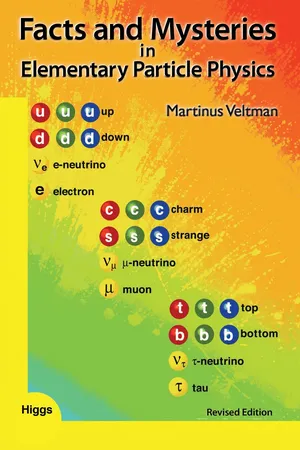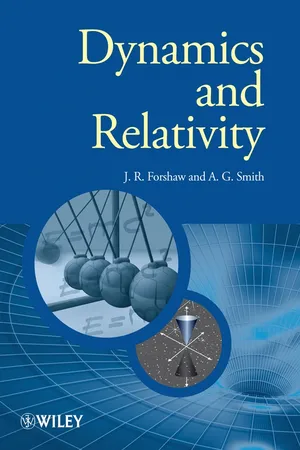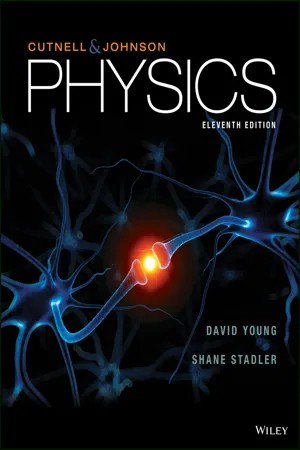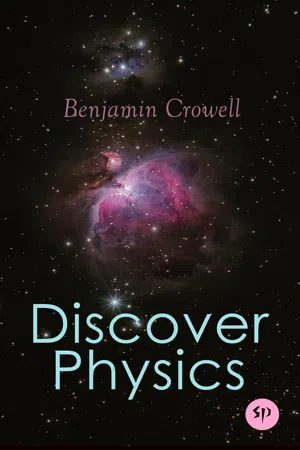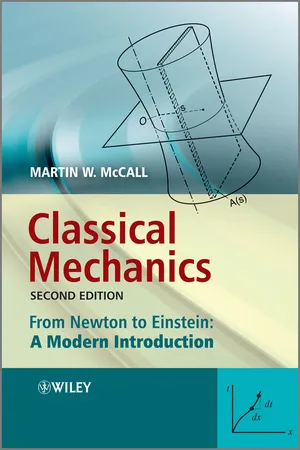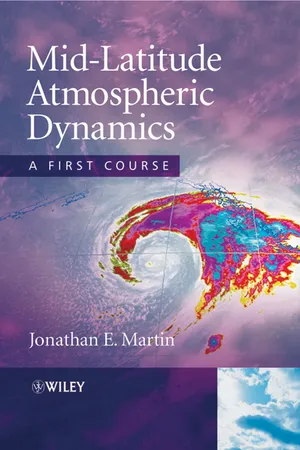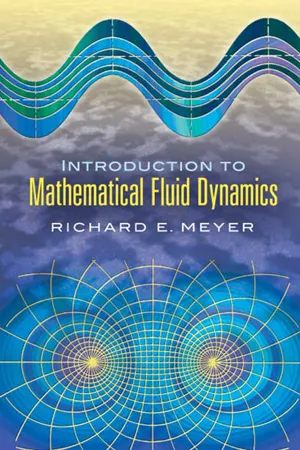Physics
Momentum
Momentum is a fundamental concept in physics that describes the quantity of motion an object possesses. It is calculated as the product of an object's mass and its velocity. Momentum is a vector quantity, meaning it has both magnitude and direction, and is conserved in a closed system, making it a crucial factor in understanding the behavior of moving objects.
Written by Perlego with AI-assistance
Related key terms
Related key terms
1 of 4
Related key terms
1 of 3
12 Key excerpts on "Momentum"
- eBook - ePub
- A. L. Stanford, J. M. Tanner(Authors)
- 2014(Publication Date)
- Academic Press(Publisher)
v .Like energy, linear Momentum is an important physical quantity because we can associate a conservation principle with it. Unlike energy, Momentum has units that are not given a special name in either system of units. Therefore, the units of Momentum are kg·m/s and slug·ft/s.In order to consider the conservation principle associated with Momentum, let us reconsider Newton’s second law, ∑F = m a , in which m may be the mass of a single particle. In light of our discussion of center of mass, we may let M represent the mass of a system of particles in which the center of mass has acceleration a cm and write ∑F = M a cm . In either case, ∑F is the net external force acting on the particle or on the system. Let us now define the Momentum P of a system of particles to be the vector sum of the momenta p of the individual particles within the system. From Equation (6-10) , the Momentum P of the system is given byP = M(6-16)vc m(6-16)Then we may state the second law in terms of linear Momentum for a particle of mass m or a system of mass M :(6-17)∑ F= m a = mdv=d t=d(m v)d tdpd t(6-17)(6-18)∑ F= Ma= Mc m=dvc md t=d(M)vc md tdPd t(6-18)In both Equations (6-17) and (6-18) - eBook - ePub
- Robert Lambourne(Author)
- 2019(Publication Date)
- CRC Press(Publisher)
However, in physics, as in life, we are often faced with situations in which predicting motion is vital, even though the relevant forces are not known in sufficient detail for Newton’s laws to be applied. Games such as snooker and pool provide an excellent example of this. When two snooker balls collide, they are in contact for a very short time during which the forces between them are rapidly varying. Predicting the outcome of such a collision using Newton’s laws would be very difficult if not impossible, yet snooker players intuitively predict the outcomes of such collisions all the time, often with astonishing accuracy. The physical quantity that makes such predictions possible is known as Momentum. Loosely speaking, the Momentum of a body is a measure of the difficulty of stopping that body. It is apparent that a locomotive travelling at 60 ms −1 ‘takes more stopping’ than a similar locomotive travelling at 30 m s −1. Likewise, a heavy locomotive travelling at 60 m s −1 ‘takes more stopping’ than a light locomotive travelling at that speed. The importance of the physical quantity that combines the mass and velocity of a body was perceived in the fifteenth and sixteenth centuries, and the concept was developed mathematically by Galileo and others in the seventeenth century. Newton called it the ‘quantity of motion’ of the body, but is now called linear Momentum and is defined as follows: The linear Momentum of a body of mass m whose centre of mass is moving with velocity υ is p = m v. (3.1) For the rest of this chapter, the word ‘linear’ will be dropped and we will simply refer to the ‘ Momentum ’ of a body. In Chapter 4, however, you will see that bodies can also possess angular Momentum, and you must not confuse the two. Now mass is a positive scalar quantity, and velocity is a vector quantity that can be specified in three dimensions in terms of its components υ = (υ x, υ y, υ z) - Martinus J G Veltman(Author)
- 2018(Publication Date)
- WSPC(Publisher)
Energy, Momentum and Mass-Shell 4.1 Introduction The aim of this Chapter is to explain the mechanical properties of elementary particles that will form the basis of much that we shall be discussing. In particular, it is necessary to have a good understanding of Momentum and energy, and, for a single particle, the relation between the two, called the mass-shell relation. Energy and Momentum are important concepts because of two facts: first they are, in the context of quantum mechanics, enough to describe completely the state of a single free particle (disregarding internal properties such as spin and charge), and second, they are conserved. For energy this is well known: for any observable process the initial energy equals the final energy. It may be distributed differently, or have a different form, but no energy disappears. If we burn wood in a stove the chemical energy locked in the wood changes into heat that warms the space where the stove is burning; eventually this heat dissipates to the outside, but does not disappear. This is the law of conservation of energy. Similarly there is a law for conservation of Momentum and we shall try to explain that in this section for simple collision processes. The fact that a description of the state of a particle in terms of its energy and Momentum is a complete description is very much at the heart of quantum mechanics. Normally we specify the state of a particle by its position and its Momentum at a given time: where, when and how does it move. Momentum a is a vector, meaning that it has a direction: Momentum has thus three components, Momentum in the x, y and z directions. That means that for the specification of the state of a particle we have three space coordinates plus the time and the three components of the Momentum. In quantum mechanics, when you know precisely the Momentum of a particle no information on its location can be given. Heisenberg’s famous uncertainty relation forbids this- eBook - ePub
- Jeffrey Forshaw, Gavin Smith(Authors)
- 2014(Publication Date)
- Wiley(Publisher)
m is the sum of the masses of the constituent particles. In this way, the dynamical behaviour of an extended body is reduced to the motion of its centre of mass. However, for an extended body, centre-of-mass motion is only part of the story. An extended object may also exhibit internal motion. For example, the centre-of-mass motion of our Solar System tells us nothing about the elliptical orbits of the individual planets and moons within it and the parabolic motion of the centre of mass of a ball in flight tells us nothing about the spin of the ball. The internal motion of an extended system is usually more complicated than the motion of the centre of mass since it may well be associated with more degrees of freedom. To deal with this complexity, physicists look for conserved quantities; properties of the motion that do not change with with time, irrespective of the internal interactions that occur between the constituent particles. We have seen in the last chapter that Momentum and energy are important conserved quantities. In this chapter we examine another conserved quantity, which appears both in classical and quantum physics. That conserved quantity is angular Momentum.4.1 ANGULAR Momentum OF A PARTICLE
To introduce the subject of angular Momentum we consider the simplest possible system, a particle with position vector r and Momentum p. The angular Momentum l is defined to be(4.1 )From the properties of the vector product this is a vector perpendicular to the plane containing r and p.Figure 4.1 Particle travelling in the x -y plane.Example 4.1.1 A particle moves with Momentum p and position vector ras shown in Figure 4.1 - eBook - ePub
- John D. Cutnell, Kenneth W. Johnson, David Young, Shane Stadler(Authors)
- 2018(Publication Date)
- Wiley(Publisher)
linear Momentum, which is defined as follows:DEFINITION OF LINEAR Momentum
The linear Momentum(7.2)p →of an object is the product of the object's mass m and velocityv →:Linear Momentum is a vector quantity that points in the same direction as the velocity.p →= mv →SI Unit of Linear Momentum: kilogram · meter/second (kg · m/s)Newton's second law of motion can now be used to reveal a relationship between impulse and Momentum. Figure 7.3 shows a ball with an initial velocityapproaching a bat, being struck by the bat, and then departing with a final velocityv →0. When the velocity of an object changes fromv →ftov →0during a time interval Δt, the average accelerationv →fis given by Equation 2.4 asa →¯=a →¯−v →fv →0Δ tAccording to Newton's second law,(7.3)∑the average acceleration is produced by the net average force= mF →¯a →¯∑. HereF →¯∑represents the vector sum of all the average forces that act on the object. Thus,F →¯∑= mF →¯(=)−v →fv →0Δ tm− mv →fv →0Δ tIn this result, the numerator on the far right is the final Momentum minus the initial Momentum, which is the change in Momentum. Thus, the net average force is given by the change in Momentum per unit of time.* Multiplying both sides of Equation 7.3 by Δt yields Equation 7.4 , which is known as the impulse–Momentum theorem.FIGURE 7.3When a bat hits a ball, an average forceis applied to the ball by the bat. As a result, the ball's velocity changes from an initial value ofF →¯(top drawing) to a final value ofv →0v →f - eBook - ePub
- Benjamin Crowell(Author)
- 2018(Publication Date)
- Studium Publishing(Publisher)
Accounting works because money is conserved. Apparently, something is also conserved when the balls collide. We call it Momentum. Momentum is not the same as velocity, because conserved quantities have to be additive. Our pool balls are like identical atoms, but atoms can be stuck together to form molecules, people, and planets. Because conservation laws work by addition, two atoms stuck together and moving at a certain velocity must have double the Momentum that a single atom would have had. We therefore define Momentum as velocity multiplied by mass.This is our second example of Noether’s theorem:Conservation of MomentumThe quantity defined by Momentum = mv is conserved.symmetry conserved quantity time translation ⇒ mass-energyspace translation ⇒ Momentum Conservation of Momentum for pool ballsexample 4‣ We have to check whether the total initial Momentum is the same as the total final Momentum. dark ball’s initial Momentum + light ball’s initial Momentum =? dark ball’s final Momentum + light ball’s final Momentum Yes, Momentum was conserved:‣ Is Momentum conserved in figure g/1?0 + mv = mv + 0h / example 5Figure skaters push off from each otherexample 5left skater’s initial Momentum + right skater’s initial Momentum =? left skater’s final Momentum + right skater’s final Momentum Momentum was conserved:Let’s revisit the figure skaters from the example on page 11. I argued there that if they had equal masses, then mirror symmetry would imply that they moved off with equal speeds in opposite directions. Let’s check that this is consistent with conservation of Momentum:0 + 0 = m × (−v) + mvThis is an interesting example, because if these had been pool balls instead of people, we would have accused them of violating conservation of energy. Initially there was zero kinetic energy, and at the end there wasn’t zero. (Note that the energies at the end don’t cancel, because kinetic energy is always positive, regardless of direction.) The mystery is resolved because they’re people, not pool balls. They both ate food, and they therefore have chemical energy inside their bodies: - eBook - ePub
Introductory Physics
Summaries, Examples, and Practice Problems
- Michael Antosh(Author)
- 2023(Publication Date)
- CRC Press(Publisher)
Linear Momentum and CollisionsDOI: 10.1201/9781003005049-77.1 Introduction: Collisions and Momentum
Collisions happen often, whether it is a charging foul in basketball, two people literally bumping into each other, or two bumper cars bumping into each other. Chapter 6 talked about the idea that the amount of something can stay the same during a certain event – this is called a conservation law. In Chapter 6 it was mechanical energy that stayed the same. For collisions, a quantity called linear Momentum stays the same.7.2 Linear Momentum
Linear Momentum is equal to mass times velocity. It is represented by the letter p:p = m∙v(7.2.1)(p is the magnitude of Momentum, m is mass, v is the magnitude of velocity) Linear Momentum is a vector. This means:- In one dimensional problems (with motion in a straight line), you need to have one direction be positive for the velocity, and one direction be negative. This is just like the problems done in Chapter 2 , with acceleration, velocity, and displacement.
- When we do two-dimensional collisions later in the chapter, we’ll use an equation for each of the x and y components. It might help to think of it as px = m∙vx and py = m∙vy
7.3 Linear Momentum Problems Without Collisions
Two problem types involve linear Momentum but don’t involve collisions:- Calculate the amount of linear Momentum. For these problems, just use p = m∙v (Equation 7.2.1). If the direction is requested, the direction of Momentum is the same direction as the velocity.
- Calculate the change in linear Momentum, between an initial and final time point. Here, you use Equation 7.2.1 twice – once at the final time point and once at the initial time point. As with many “change” questions, you take the (final amount) – (initial amount). If the problem is one-dimensional, the equation would be:
- eBook - ePub
Science and Nature
Past, Present, and Future
- Carolyn Merchant(Author)
- 2017(Publication Date)
- Routledge(Publisher)
1The Momentum of a body is actually the Newtonian force F acting through a time, since v = at and mv = mat = Ft . The kinetic energy is the Newtonian force acting over a space, since v 2 = 2as and mv 2 = 2mas or ½ mv 2 = Fs . Although confusion over these two definitions is apparent in the various arguments of the contenders, many other sources of confusion entered into the debates. Some of these factors are clarified in the following discussion of the early years of the vis viva controversy.The controversy had its roots in Descartes’ law of the quantity of motion, as discussed in his Principia philosophiae of 1644.2 It was Descartes’ belief that God, the general cause of all motion in the universe, preserves the same quantity of motion and rest put into the world at the time of creation. The measurement of this quantity is mv , implied in the statement “we must reckon the quantity of motion in two pieces of matter as equal if one moves twice as fast as the other, and this in turn is twice as big as the first.”3 The conservation of quantity of motion is derived from God’s perfection, for He is in Himself unchangeable and all His operations are performed in a perfectly constant and unchangeable manner. There thus exists an absolute quantity of motion that for the universe remains constant. When the motion in one part is diminished, that in another is increased by a like amount. Motion, like matter, once created cannot be destroyed because the same amount of motion has remained in the universe since creation. It is evident from Descartes’ application of the principle in his rules governing the collision of bodies that this quantity mv conserves only the magnitude of the quantity of motion and not its direction; that is, velocity is always treated as a positive quantity, |v | rather than as a vector quantity whose direction is variable. Beginning in 1686, Leibniz wrote a series of papers objecting that the quantity that remains absolute and indestructible in nature is not quantity of motion m |v | but vis viva , or living force, mv 2 - eBook - ePub
- Sir James H. Jeans(Author)
- 2013(Publication Date)
- Dover Publications(Publisher)
, so that(70)By the Momentum of a particle, as we have already seen (§ 20), is meant the product of its mass and velocity. The Momentum of a particle is therefore a vector of components mu, mv, mw, and mu may be spoken of as the x -component of the Momentum. Each particle of the system will have Momentum, and the sum of the x -components will be ( mu ), the quantity which appears on the right hand of equation (70).We may now replace equation (69) by(71)where X denotes the sum of the x -components of the external forces, and mu is the sum of the x -components of Momentum.CONSERVATION OF LINEAR Momentum
179. When there are no external forces acting, X = 0, so that(72)Similarly we have(73)(74)These equations express that the quantitiesmu , mv , mwdo not vary with the time. That is to say, the components of the total Momentum are constant, so that the total Momentum, regarded as a vector, is constant. This is known as the principle of the conservation of Momentum. Stated in words it is as follows:When any system of particles moves without being acted on by external forces, the total Momentum of the system remains constant in magnitude and direction.MOTION OF CENTER OF GRAVITY OF SYSTEM
180. Let us now return to the consideration of the general equations (71),(75)Let , , denote the coordinates of the center of gravity of the particles of the system at any instant, and let the components of the velocity of this point be denoted by , , , . Then we have(76)The value of is, by equation (8),Thusso that if M is the total mass, m , of all the particles, we havemu =Equation (75) now becomesM.(77)and similarly we have the equations(78)(79)Remembering thatare the components of acceleration of the center of gravity, we see that the motion of the center of gravity is the same as it would be if it were replaced by a particle of mass M , acted upon by a force of components X , Y , Z - eBook - ePub
Classical Mechanics
From Newton to Einstein: A Modern Introduction
- Martin W. McCall(Author)
- 2011(Publication Date)
- Wiley(Publisher)
Although at the level of particle physics experiments it is harder to identify these ‘alternative’ sinks for energy in inelastic collisions, it may seem that violation of energy conservation is less of a problem than Momentum conservation. So we have a dichotomy: either we must abandon the Newtonian expression for Momentum, or we must redefine Momentum in such a way that it is conserved. This cuts right through the middle of Newton’s laws, for we saw in Chapter 1 that the conservation of Momentum for isolated systems was an emergent property of the second law. Newtonian physics is in serious trouble if we are going to attempt to maintain the conservation of Momentum for isolated systems. Now that we are faced with the possibility of abandoning Newtonian Momentum, once again the issues over the role of definition and physical law, discussed in Section 1.5, rear their head again. If Momentum is going to be defined to be a quantity that is conserved in high-speed collisions (with the additional requirement that it reduces to Newtonian Momentum for low speeds) then is not our reasoning circular? No! The point is that one experiment is not enough. The first experiment can be used to define, or propose, an expression for Momentum that satisfies the Newtonian limit condition and is conserved in that experiment. Now we can perform additional experiments to see if Momentum so defined is conserved in general. It is in the arena of these additional experiments that we are probing nature to find out if our definition is actually something of fundamental significance. So how to proceed? First, let us consider the world line of a particle on a space–time diagram (see Figure 6.1). This is simply a plot of the particle’s trajectory, or its position as a function of time. The convention is to plot time on the vertical axis and space on the horizontal axis - eBook - ePub
Mid-Latitude Atmospheric Dynamics
A First Course
- Jonathan E. Martin(Author)
- 2013(Publication Date)
- Wiley(Publisher)
3Mass, Momentum, and Energy: The Fundamental Quantities of the Physical World
Objectives
Study of the physical world tends to be focused on the quantities known as mass, Momentum, and energy. The behavior of the atmosphere is no exception to this rule. In this chapter we will investigate the manner in which these quantities and their various interactions serve to describe the building blocks of a dynamical understanding of the atmosphere at middle latitudes. We must first consider the distribution of mass in the atmosphere and the force balance that underlies this distribution. A number of insights concerning the vertical structure of the atmosphere proceed directly from this understanding.Beginning with Newton’s second law, we will construct expressions for the conservation of Momentum in the three Cartesian directions. These expressions are commonly known as the equations of motion and will serve as the fundamental set of physical relationships for all subsequent inquiry in this book. Scale analysis of the horizontal equations of motion will reveal that a simple diagnostic relationship between the mass and Momentum fields, geostrophy, characterizes the mid-latitude atmosphere on Earth. Finally, employing these equations of motion we will develop expressions for the conservation of mass and the conservation of energy. We begin by considering the distribution of mass in the atmosphere.3.1 Mass in the Atmosphere
For our purposes, we shall define mass as the measure of the substance of an object and make that measurement in kilograms (kg). Though it was not clear to ancient thinkers like Aristotle,1 the atmosphere has mass. In fact the Earth’s atmosphere has a mass of 5.265 × 1018 - eBook - ePub
- Richard E. Meyer(Author)
- 2012(Publication Date)
- Dover Publications(Publisher)
CHAPTER 2Momentum Principle and Ideal Fluid
10. Conservation of Linear Momentum
Postulate VI (Momentum Principle). A vector field f and a tensor field with components p if are defined on the closure of any fluid domain Ωt with regular boundary surface ∂Ωt so that(10.1)where n is the unit outward normal on ∂Ωt .The left-hand side of (10.1) represents the rate of change of the linear Momentum of the body of fluid which occupies the domain Ωt , and the right-hand side therefore represents the resultant external force exerted on this body of fluid. The postulate states that external force can be exerted on the fluid in two ways: by a stress acting on the surface of the fluid and by a body force ρ f acting directly on each volume element. The most common body forces are gravity, centrifugal and Coriolis forces (to be considered only in Chapter 5), and electromagnetic forces (not considered in this book). Since the postulate applies also to every subdomain of a fluid domain, p ij n j represents the i -component of force per unit area exerted across an area element with “outward” unit normal n by the fluid on the “outer” side of the area element upon the fluid on its “inner” side.It should be emphasized that this postulate is more fundamental than those of Sections 1 and 2, in the sense that Postulates V, VI, and VIII (in contrast to Postulates I to IV) hold for all of continuum mechanics.It may also be noted that the Momentum principle does not require the pointwise definition of f i and p ij . Indeed, the values of these quantities (and of the density) at a point are not directly observable, and only the integrals occurring in Postulates V and VI have strict physical meaning. As noted in Section 3, however, ρ and p ij
Index pages curate the most relevant extracts from our library of academic textbooks. They’ve been created using an in-house natural language model (NLM), each adding context and meaning to key research topics.
Explore more topic indexes
Explore more topic indexes
1 of 6
Explore more topic indexes
1 of 4


